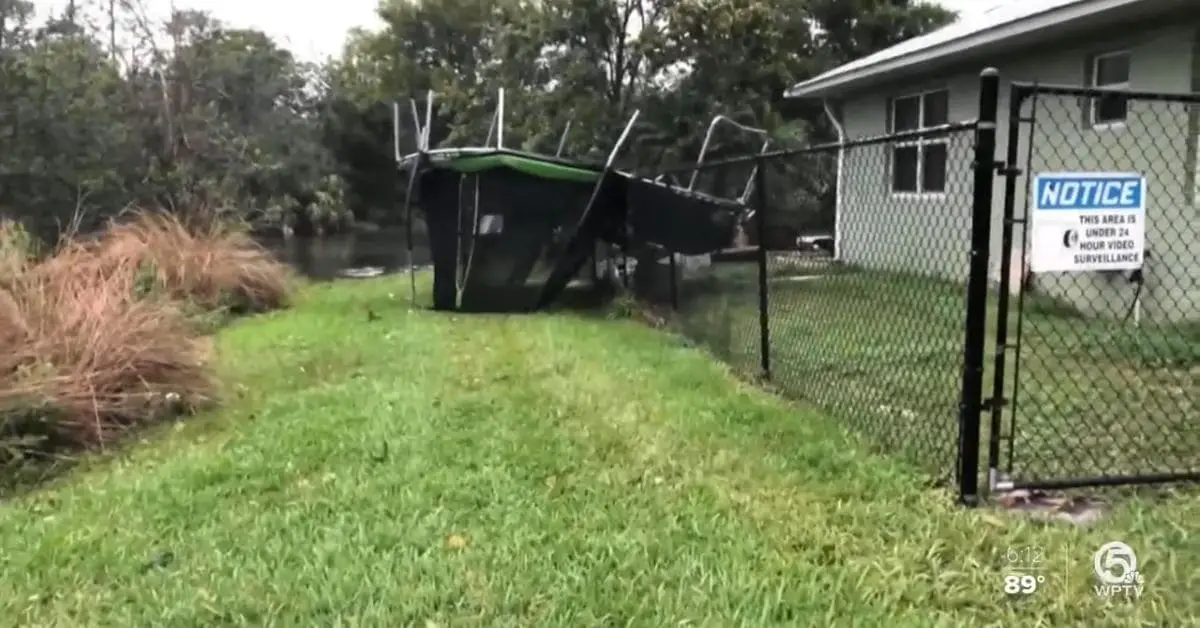Many factors are at play regarding Wind lift on a trampoline. Wind speed is the primary factor that affects lift, with higher wind speeds posing a greater risk of charge and damage.
If you are worried about how much Wind will lift a trampoline? Typically, it’s important to consider various factors. These include the size and weight of the trampoline, as well as its design and construction, which can all affect Wind lift.
It’s important to note that wind lift isn’t the only risk associated with trampoline use. Injuries from falls, collisions, and other accidents can occur, especially if proper safety guidelines aren’t followed.
Trampoline owners should prioritize proper maintenance, secure their trampolines, use appropriate safety gear, and follow all safety guidelines for trampoline use to prevent wind lifts and other safety risks.
With proper precautions, trampolines can be a fun and safe way to enjoy physical activity and outdoor recreation.
How much Wind Will Lift a Trampoline: Wind speeds of 25-45 mph are strong enough to lift a trampoline, while severe winds of 45+ mph pose an extreme risk. Proper safety precautions are crucial to prevent accidents.
Issues with Wind and Trampolines
There are several issues to consider when purchasing a trampoline, and it’s essential to take precautions to ensure its safety. Forceful winds can pose a significant danger, so it’s crucial to be prepared. Preventing accidents is important, as strong winds can be particularly hazardous.
If you don’t take proper precautions to ensure the safety of your trampoline, it’s likely to sustain damage. You may have questions about the wind-related risks associated with trampolines.
How Much Wind Will Lift a Trampoline?
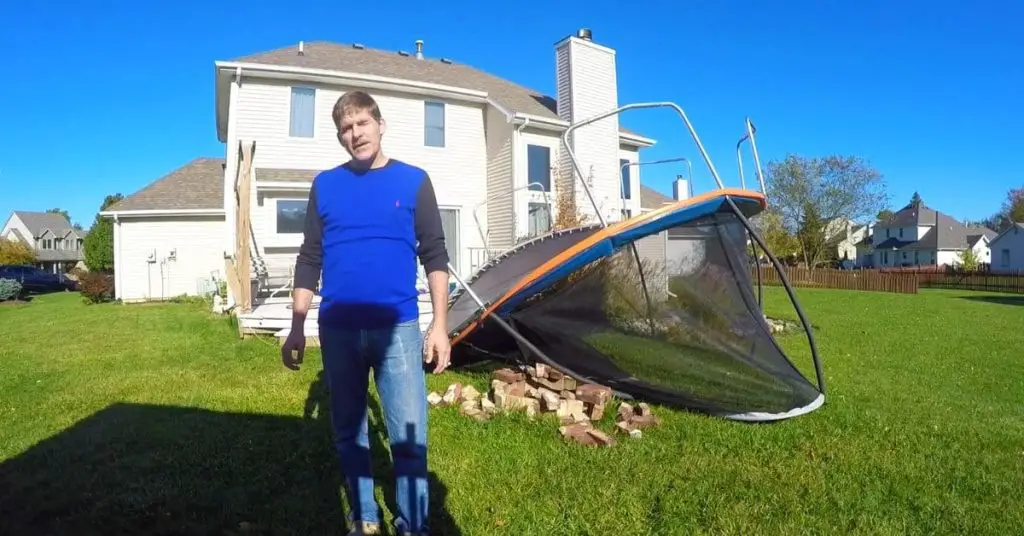
Many people mistakenly believe that only tornadoes or hurricanes can lift a trampoline, but this is untrue. Even winds as low as 25-45 mph can cause a trampoline to steal if it’s not adequately secured.
If your trampoline isn’t anchored correctly, it’s likely to move in even light winds. It’s essential to ensure that your trampoline is set up correctly to prevent it from being blown away by the Wind.
Securing Your Trampoline on Windy Days
Typically, trampolines are not at high risk of safety issues on regular windy days. You can use small U-ring loops to secure them in place. However, it’s important to note that these loops may not be strong enough to hold heavier trampolines securely.
Securing Your Trampoline in Extreme Wind Conditions
Extreme weather conditions may be rare, but they can cause significant damage to trampolines. A hurricane’s combination of heavy rainfall and violent winds can be particularly destructive.
When these conditions occur, they can cause severe damage to your trampoline, so it’s crucial to take steps to secure it properly.
If your trampoline is not adequately secured during high winds, it can move so quickly that it not only gets damaged but can also cause damage to other objects. If you live in areas prone to hurricanes, it’s essential to ensure your trampoline is appropriately anchored to prevent severe damage.
What is the Safest Option for Securing a Trampoline?
Using an anchor is generally considered the safest option for securing a trampoline. Anchoring the trampoline significantly reduces the chances of it moving during windy conditions. Choosing the appropriate anchor for your trampoline can solve half of your problems.
In terms of safety, heavy-weighted trampolines are a good option. These trampolines are not easily movable, which provides an additional level of protection. If you anchor your heavy trampoline, you can expect minimal damage to the trampoline and your property during extreme weather conditions.
Can Sandbags be used to prevent Wind lift on a Trampoline?
Using sandbags is another option to ensure the safety of your trampoline from wind lifting. Some trampolines might not be suitable for anchor kits, and in such cases, sandbags can be used alone or with anchor kits for added safety.
Sandbags are effective in keeping the trampoline stable during windy conditions. You can place sandbags on each leg of the trampoline if you already have them.
Sandbags are the best alternative for safety if anchor kits are not suitable. Inspectingting your sandbags every two months is essential essential to ensure they are in good condition.
How does the location of the trampoline affect its safety from wind lifting?
In many cases, garden trampolines are surrounded by natural and artificial barriers that help secure the trampoline without needing additional equipment. Trees and hedges in your yard can serve as wild wind barriers and prevent gusts from lifting the trampoline off the ground if placed around the perimeter.
These barriers shield against Wind, making moving harder for the trampoline. It is crucial to have these barriers in place, especially in areas prone to high winds.
With the proper placement of natural barriers, you can significantly reduce the risk of damage to your trampoline and other property in your yard.
In addition to natural barriers, tall fences and walls can act as protective barriers against strong winds that may lift a trampoline off the ground. It’s important to consider the location of your trampoline and assess the risk of it being affected by the Wind in that area.
Using Wind Stakes to Secure Your Trampoline
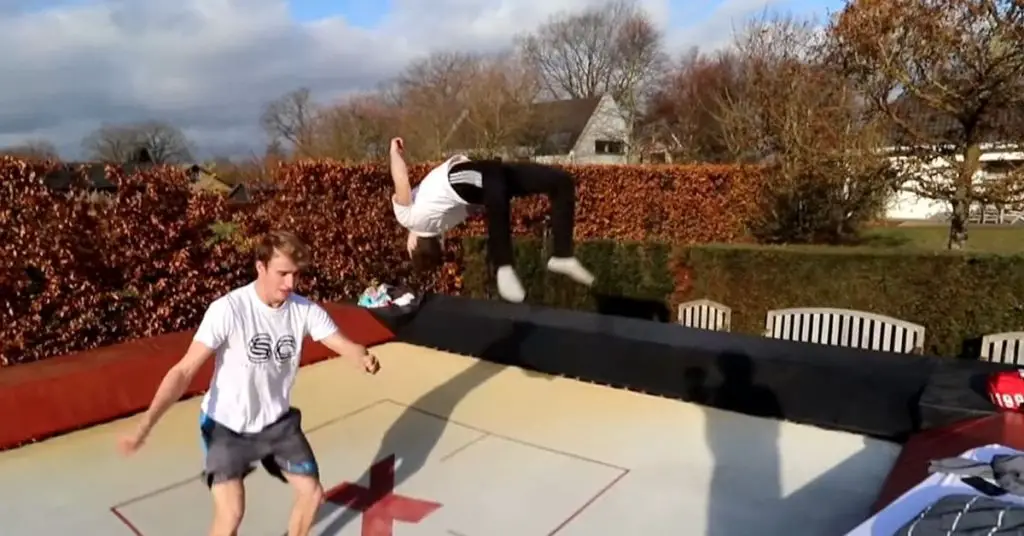
Wind stakes are a great tool to keep your trampoline stable and prevent it from being blown away by strong winds. Compared to other methods, wind stakes are a long-lasting solution. If you plan on keeping your trampoline in your garden for a long time, it’s best to buy wind stakes to secure it there.
These wind stakes come in “U” and “J” shapes and can secure the trampoline to the ground in either configuration. To do this, you’ll need a sledgehammer.
They’re usually made of galvanized steel, and you’ll need a set of four wind stakes to anchor your trampoline to the ground securely.
U-Shaped Wind Stakes for Trampoline Stability:
“U” shaped wind stakes are considered the most accessible and cheapest anchors to install; however, they offer less security than “J” shaped wind stakes. Minimizing the chances of your trampoline is exposed to storms and high-wind conditions is recommended.
J-Shaped Wind Stakes for Trampoline Stability:
On the flip side, wind stakes shaped like a “J” are considered the most efficient way to prevent your trampoline from being carried away by the Wind. They provide optimal protection against strong winds, and surprisingly, they are compatible with gardens and require less structured wiring.
You can secure your trampoline to the ground with a U-shaped or J-shaped wind stake. Knowing that your trampoline won’t be blown away will give you peace of mind even when there are strong winds.
How to Protect Your Trampoline during Storms?
If you live in a storm-prone area, the best way to protect your trampoline from strong winds is to disassemble it and keep it inside. This may not be the most convenient option, but it will prevent your trampoline from being damaged. When the weather calms down, you can set it up again.
Alternatively, you can use “J” shaped wind stakes to secure your trampoline to the ground. You can also use sandbags and attach them to the stakes for extra protection. This may help prevent your trampoline from being blown away.
How to Weigh Down a Trampoline on Concrete?
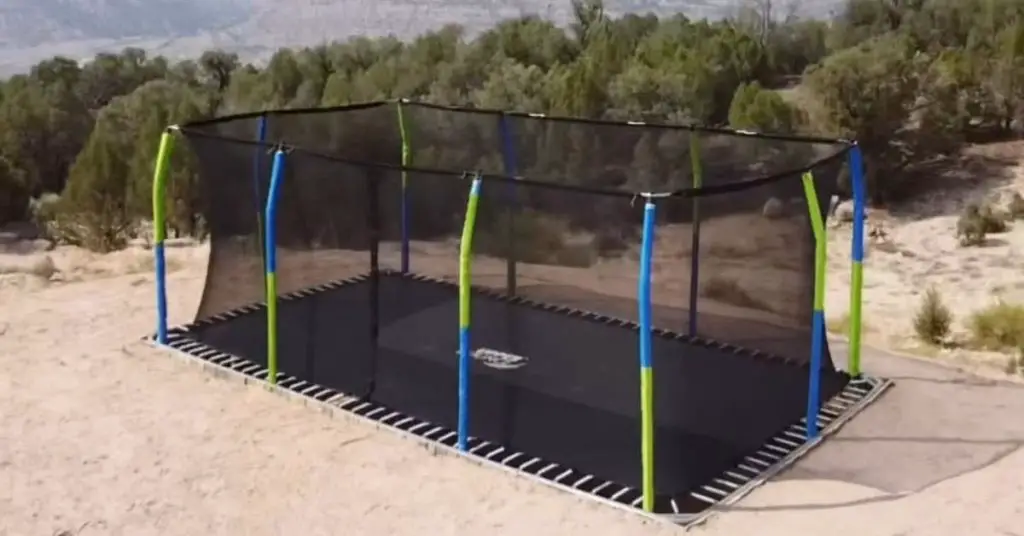
Sandbags are the best option for weighing down a trampoline on concrete because they can be easily moved around. If you use enough sandbags and secure them to the trampoline’s legs, even strong storms won’t be able to knock it over.
Wind pegs, anchorage kits, and augers won’t work well on concrete because they won’t be able to secure tightly. This means that the trampoline will be less protected against being blown away.
What is the required Weight to Hold down a Trampoline?
There is no one-size-fits-all answer to how much weight is needed to hold a trampoline down. It depends on various factors, such as the location, type of trampoline, and the surface it is placed on.
In areas with lower wind speeds, using U-shaped wind stakes might be sufficient to provide some protection.
However, sandbags or J-shaped wind pegs are a better option for areas prone to storms and high winds. They can withstand severe winds and prevent the trampoline from being blown away. When using sandbags, it is recommended to use six to eight bags, depending on the number of legs the trampoline has.
How Much Wind Can a Trampoline Take: Factors Affect
Various factors can affect how much Wind a trampoline can withstand, including:
Wind Speed:
The wind speed is the most important factor that determines how much Wind a trampoline can take. The stronger the Wind, the more likely a trampoline is to be damaged or blown away.
Generally, trampolines can withstand winds up to 15-20 mph without any problems. However, when the wind speed increases beyond this threshold, you should take precautions to protect your trampoline.
If you live in an area prone to high winds or storms, purchasing a trampoline with a high wind rating or taking extra measures to secure it is recommended.
Trampoline Size and Weight:
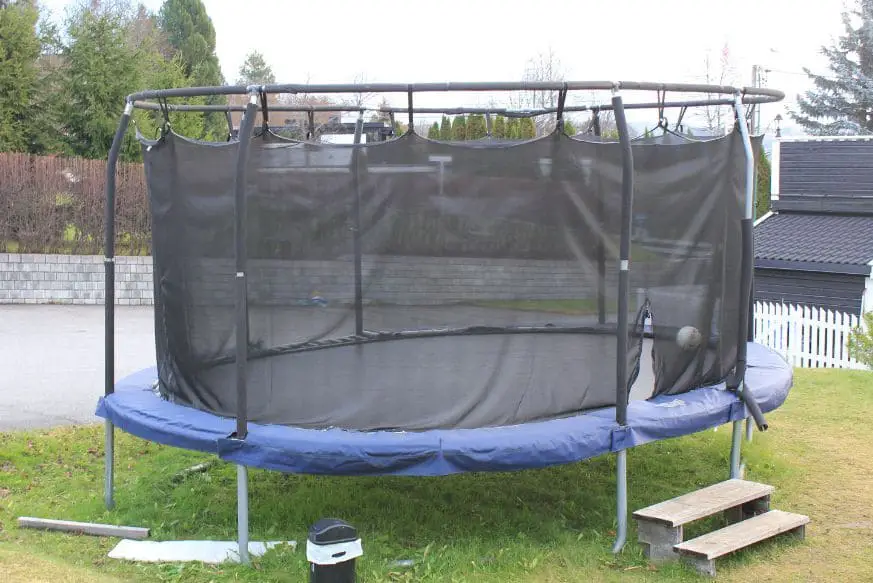
The size and weight of a trampoline also play a significant role in determining how much Wind it can handle. Larger trampolines with more surface area are more susceptible to wind damage than smaller ones.
Additionally, heavier trampolines are generally more stable and less likely to be blown away by the Wind. When selecting a trampoline, consider the weight and size of the trampoline as well as the maximum wind speed in your area.
Trampoline Design and Construction:
The design and construction of a trampoline can also affect how much Wind it can handle. Trampolines that are well-constructed with sturdy frames and strong mat materials are less likely to be damaged by the Wind.
Additionally, trampolines with wind-resistant features such as netting or enclosures can also help to protect against wind damage. When purchasing a trampoline, consider the materials used in its construction and look for features that will provide added wind protection.
Wind Speeds and their Effects on Trampolines
The wind speed is the most crucial factor that determines the safety of a trampoline.
Light Winds (0-10 mph):
When wind speeds are low, between 0 and 10 mph, the impact on a trampoline is minimal. However, it’s still important to take some safety precautions. It’s recommended to secure the trampoline with either stakes or weights and to avoid jumping on it during windy conditions.
Additionally, it’s important to check the trampoline’s condition regularly for any signs of wear and tear.
Moderate Winds (10-25 mph):
When Wind speeds increase to between 10 and 25 mph, there is an increased lift risk. This means the trampoline can be lifted off the ground, potentially causing damage or injury.
It’s essential to secure the trampoline with stakes or weights and to avoid jumping on it during these conditions. It’s also recommended to remove the safety netting, as it can act as a sail and increase the lift risk.
Strong Winds (25-45 mph):
At wind speeds of 25-45 mph, there is a high risk of lift, and it’s essential to take precautions to prevent damage or injury. The trampoline should be secured with stakes or weights, and removing the safety netting and any other accessories is recommended. The trampoline should also be moved to a sheltered location like a garage or shed.
Severe Winds (45+ mph):
At wind speeds of 45+ mph, there is an extreme risk of lift and damage. It’s recommended to take down the trampoline and store it indoors until the severe weather has passed. If this isn’t possible, the trampoline should be secured with heavy weights and additional measures such as sandbags or extra stakes.
It’s important never to use a trampoline during severe weather conditions, as the risk of injury or damage is too high.
How to prevent Wind Lift on a Trampoline?
Preventing Wind lift on a trampoline is essential to ensure the safety of users and protect the trampoline from damage. Here are some tips on how to prevent wind lift:
Securing the Trampoline:
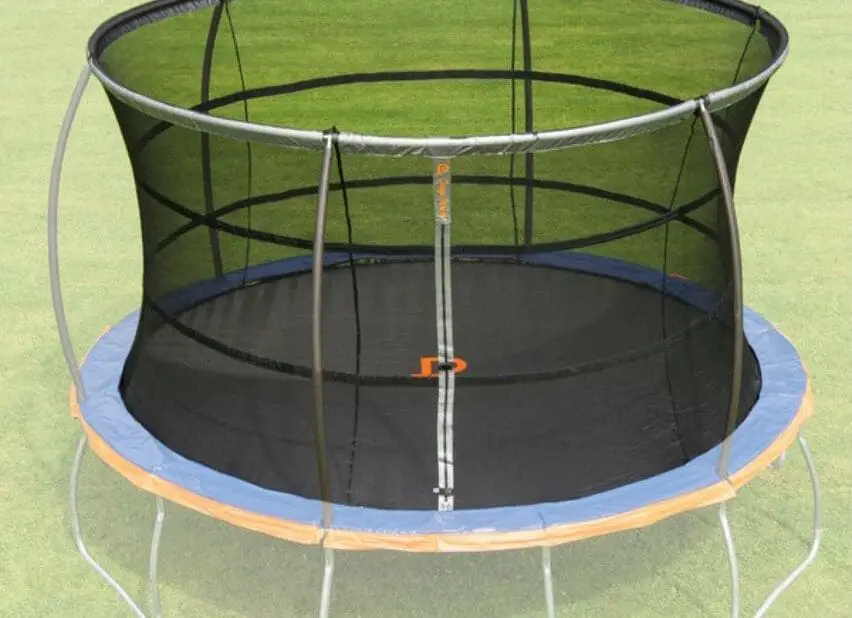
Preventing a wind lift on a trampoline is essential to ensure the safety of anyone using it and protect it from damage. Securing the trampoline is one of the best ways to prevent wind lift.
Anchors and stakes can be used to keep the trampoline in place by driving them into the ground and attaching them to the trampoline legs.
This method ensures that the trampoline is securely fixed to the ground and will not be lifted by strong winds. Tethers and tie-downs can also be used to keep the trampoline in place.
These are attached to the trampoline’s frame and then secured to a nearby structure or object, such as a fence post or tree. By anchoring the trampoline with these methods, you can help prevent the trampoline from being lifted by strong winds.
Use of Trampoline Covers and Enclosures:
Another way to prevent Wind lift on a trampoline is to use a cover or enclosure. A trampoline cover can provide protection from Wind, rain, and other weather conditions that can potentially damage the trampoline.
An enclosure, on the other hand, can create a barrier around the trampoline that can help block Wind and prevent it from lifting. Both covers and enclosures can increase the trampoline’s and its users’ safety and protection.
However, it is important to properly install and use covers and enclosures to ensure their effectiveness in preventing Wind lift. They should be securely attached to the trampoline and not loose or flapping in the Wind, which could increase the lift risk.
It is recommended to follow the manufacturer’s instructions for installation and maintenance. Regularly inspecting the covers and enclosures for wear and tear and replacing them as needed is also crucial to their effectiveness.
With proper installation and maintenance, covers and enclosures can effectively prevent Wind lift on a trampoline.
Trampoline Maintenance to Prevent Wind Lift
Regular trampoline maintenance is essential to prevent wind lift and ensure the safety of its users.
Regular Inspection and Maintenance:
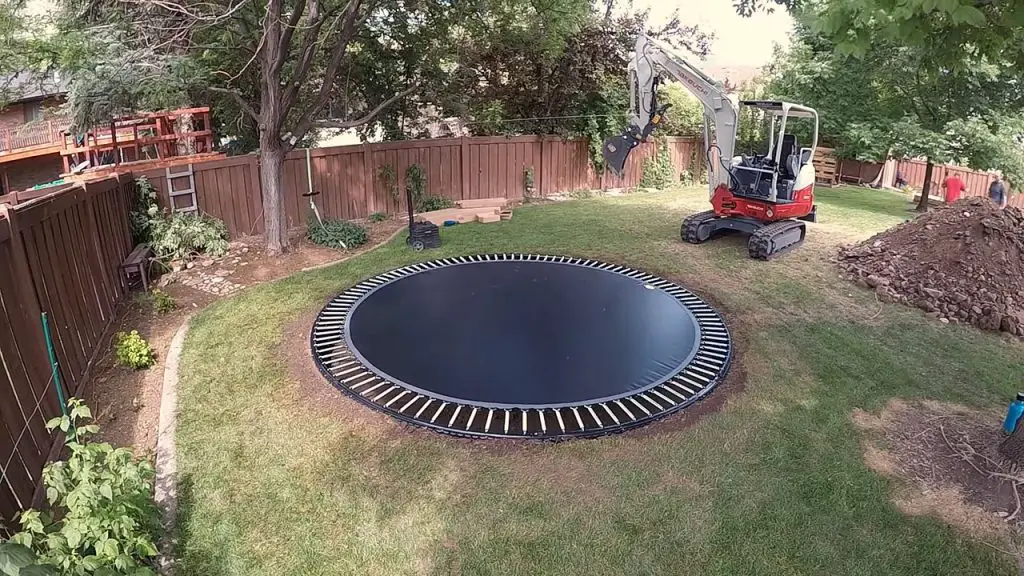
Regular inspection and maintenance of the trampoline can prevent Wind lift. Inspecting the trampoline before and after each use is recommended to identify any damage or wear and tear.
This can include checking the frame, springs, mat, and any other components for signs of damage or deterioration. Regular maintenance can help ensure that the trampoline is in good condition and functioning properly, reducing the risk of Wind lift.
Repairing any Damage Promptly:
If any damage is identified during an inspection, it is important to repair it promptly to prevent further damage or deterioration. This can involve replacing any worn or damaged parts, such as springs or mats, or repairing any tears or holes.
Any repairs should be done in accordance with the manufacturer’s instructions or by a qualified professional.
Proper Storage During Severe Weather:
Proper storage of the trampoline during severe weather, such as high winds or storms, can prevent Wind lift. The trampoline should be disassembled and stored in a safe, secure location.
This can include a garage, shed, or other covered area. If disassembly is impossible, the trampoline should be securely anchored to the ground and covered with a weatherproof cover to protect it from Wind and other elements.
Overall, regular inspection and maintenance, prompt repair of any damage, and proper storage during severe weather can help prevent Wind lift on a trampoline and ensure its safety and longevity.
Safety Guidelines for Trampoline Use in Windy Conditions
Trampolines can be fun and exciting, but it is essential to take safety precautions, especially in windy conditions. Here are some guidelines to follow:
Appropriate Clothing and Footwear:
When using a trampoline in windy conditions, it is important to wear appropriate clothing and footwear to prevent injury. Tight-fitting clothing that does not flap in the wind and closed-toe shoes with good grip are recommended.
Adult Supervision and Restrictions on Use:
Adults should always supervise children using a trampoline, especially in windy conditions. It is also important to restrict use to one person at a time and to prohibit flips and other high-risk activities.
Proper Technique and Jumping Practices:
Proper technique and jumping practices can also help prevent injury in windy conditions. Jumping should be controlled and limited to a low height, with a focus on maintaining balance and stability.
Users should also avoid jumping near the edges of the trampoline and should always land in the center.
Limiting Use in High Winds:
In high winds, limiting or avoiding trampoline use is best. If the wind speed exceeds the manufacturer’s recommended limit, the trampoline should not be used. It is important always to follow safety guidelines and manufacturer recommendations to prevent injury and damage to the trampoline.
Legal and Insurance Considerations for Trampoline Ownership
Owning a trampoline comes with legal and insurance considerations that are important to remember to protect yourself and your property. Here are some things to consider:
Liability Risks and Homeowner’s Insurance:
Trampolines present significant liability risks to homeowners. Accidents and injuries on trampolines can result in costly medical bills and legal claims. Therefore, homeowners with trampolines must have appropriate liability insurance coverage.
Most homeowner’s insurance policies provide some coverage for trampoline-related accidents, but coverage amounts and requirements vary by insurance provider and state.
Some insurance providers may require specific safety measures, such as enclosing the trampoline or limiting its use to specific age groups, to provide coverage.
Homeowners should review their insurance policies carefully and consider purchasing additional liability coverage.
Regulations and Laws Regarding Trampoline Use:
Local and state regulations regarding trampoline ownership and use also vary widely. Some jurisdictions have specific laws and regulations regarding trampoline use, such as requiring safety enclosures or limiting use to certain times of day.
Homeowners should research local and state laws regarding trampolines and ensure they comply with all regulations.
Risk Management Strategies for Trampoline Owners:
To minimize liability risks and ensure the safe use of trampolines, homeowners should implement risk management strategies. This may include installing safety enclosures, limiting use to specific age groups, and enforcing strict safety rules and practices.
Homeowners should also regularly inspect their trampolines for damage or wear and tear and perform necessary repairs promptly. Additionally, homeowners should consider obtaining liability waivers from anyone who uses the trampoline.
Waivers can help protect homeowners from legal claims in the event of an accident or injury on the trampoline.
FAQs:
Q:1 Can wind alone lift a trampoline off the ground?
Wind alone is not usually enough to lift a trampoline off the ground. However, if the Wind is strong enough, it can cause the trampoline to lift, especially if it is not secured properly.
Q:2 How much wind speed is required to lift a trampoline?
The wind speed required to lift a trampoline depends on various factors, such as the size and weight of the trampoline, the design and construction, and the surface it is placed on. However, generally, wind speeds above 25 mph can increase the risk of lift.
Q:3 Can using a trampoline cover or enclosure prevent Wind lift?
Using a trampoline cover or enclosure can help prevent wind lift by creating a barrier around the trampoline that can help block Wind. However, properly installing and using covers and enclosures are essential to ensuring their effectiveness in preventing Wind lift.
Q:4 What are the safety guidelines for trampoline use in windy conditions?
The safety guidelines for trampoline use in windy conditions include appropriate clothing and footwear, adult supervision, proper technique, and jumping practices, and limiting use in high winds.
Q:5 Is trampoline ownership associated with legal and insurance considerations?
Yes, trampoline ownership is associated with legal and insurance considerations. Liability risks are associated with owning a trampoline, which may affect homeowner’s insurance. Moreover, regulations and laws regarding trampoline use should be followed.
Q:6 Can homeowner’s insurance cover trampoline-related accidents?
Homeowner’s insurance may or may not cover trampoline-related accidents, depending on the insurance policy and the circumstances of the accident. Some insurance policies may exclude trampoline-related accidents, while others may require certain safety measures to be in place.
Q:7 What are the risk management strategies for trampoline owners?
The risk management strategies for trampoline owners include securing the trampoline properly, using a cover or enclosure, regular inspection and maintenance, repairing any damage promptly, proper storage during severe weather, following regulations and laws regarding trampoline use, and obtaining liability insurance.
Conclusion:
In conclusion, Wind can be a significant risk factor for trampoline owners, and understanding the factors that can affect wind lift is crucial for ensuring safety. The size and weight of the trampoline, its design and construction, and the wind speed are all critical factors to consider.
It is important to secure the trampoline properly using anchors, stakes, tethers, and tie-downs and to use covers and enclosures for added protection. Regular inspection and maintenance of the trampoline is also necessary, and limiting use in high winds is recommended.
Additionally, trampoline owners should be aware of the legal and insurance considerations involved with the ownership and the safety guidelines for use in windy conditions.
By taking these factors into account and implementing appropriate risk management strategies, trampoline owners can help ensure the safety of themselves and their loved ones while enjoying the many benefits of trampolining.
We hope you will be well aware of how much Wind will lift a trampoline after reading this comprehensive article. If you have any questions, feel free to comment below!

